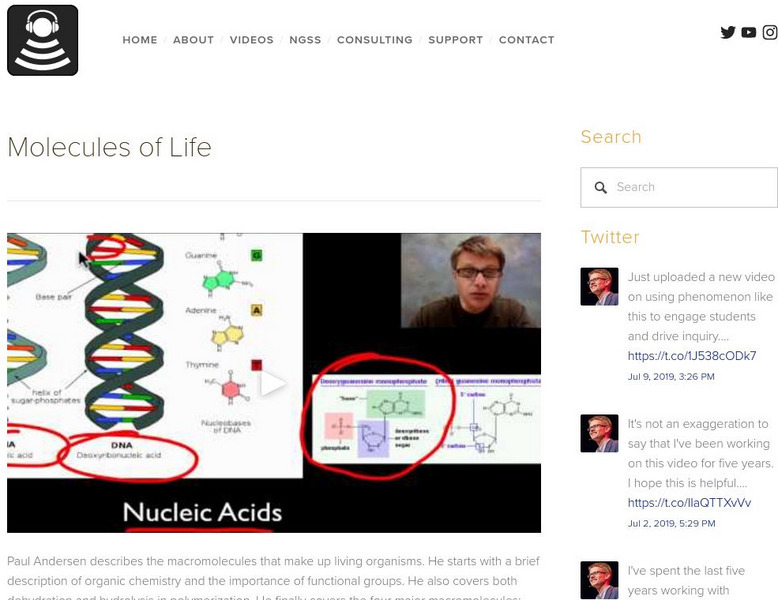Amoeba Sisters
Biomolecules (Updated 2023)
Explore the four biomolecules and their importance for organisms and the structure and function of their cells! This 2023 UPDATED Biomolecules Amoeba Sisters video has some more detail and improved art from the 2016 Amoeba Sisters...
TED-Ed
TED-Ed: From DNA to Silly Putty, the diverse world of polymers - Jan Mattingly
You are made of polymers, and so are trees and telephones and toys. A polymer is a long chain of identical molecules (or monomers) with a range of useful properties, like toughness or stretchiness -- and it turns out, we just can't live...
Bozeman Science
Biological Molecules
Paul Andersen describes the four major biological molecules found in living things. He begins with a brief discussion of polymerization. Dehydration synthesis is used to connect monomers into polymers and hydrolysis breaks them down...
Bozeman Science
Proteins
Paul Andersen explains the structure and importance of proteins. He describes how proteins are created from amino acids connected by dehydration synthesis. He shows the importance of chemical properties in the R-groups of individual...
Bozeman Science
The Molecules of Life
Paul Andersen describes the macromolecules that make up living organisms. He starts with a brief description of organic chemistry and the importance of functional groups. He also covers both dehydration and hydrolysis in polymerization....
Curated Video
Gel Electrophoresis
"Gel Electrophoresis” explores the process of chromatography, focusing on gel electrophoresis and how it is used in the field of forensics.
Curated Video
The Importance of Carbon
The Importance of Carbon analyzes the importance of carbon by explaining how carbon is uniquely suited to form biological macromolecules
JJ Medicine
Amino Acid Grouping - Basics for Beginners - Biochemistry Lesson
Hey guys! In this video, I discuss the grouping and classification of amino acids. In particular, I discuss polar/non-polar, acidic/basic, branched chain amino acids, hydroxyl group containing amino acids, aromatic amino acids, and...
Nature League
What is Life? - Lesson Plan
In this first Nature League Lesson Plan, Brit introduces the channel and goes through the characteristics of life on Earth, including the importance of carbon. What makes life /life/ is pretty amazing!
Bozeman Science
Environmental Matter Exchange
Why did carbon marry hydrogen? They bonded well from the minute they met. Here is a video that focuses on the essential chemicals for life: water, carbon, nitrogen, and phosphorus. It relates each of these to macromolecules and the way...
Bozeman Science
Biological Molecules
Focus on macro-molecules including nucleic acids, proteins, lipids, and carbohydrates. A video explains which are monomers, which form polymers, and the process of changing from one to the other. It also covers the characteristics of...
Bite Sci-zed
Saturated vs. Unsaturated Fats
What are good fats and bad fats? Learn about the structure and function of lipids and how that relates to carbon bonding. Scholars explore the structural differences between saturated and unsaturated fats and examine relevant...
Nature League
What Is Life? - Lesson Plan
The first lesson in the five-part What is Life? series addresses the definition of life. It discusses characteristics, why the concept of carbon-based life is important, and the macro-molecules of life on Earth.
Bozeman Science
Hierarchy of Life
The leader of the biology gang is known as the nucleus. In the video, learners see the different levels of the hierarchy of life. Scholars explore each level, listening to descriptions and seeing examples of each one. It is the second...
Bozeman Science
Molecules of Life
Introduce the macromolecules that make up living organisms. An instructive explains functional groups, dehydration and hydrolysis, and the four types of macromolecules. Video is the seventh in a series of 10.
Bozeman Science
Polymers
High school chemists concentrate on the formation of polymers through condensation reactions. A video also explains the process of breaking them down through hydrolysis.
Ricochet Science
Organization of Life
What do matryoshka dolls have to do with the organization of life? Young scientists learn about the levels of organization of life in the last installment of a five-part video series. The video covers the cellular, organismal, and...
Khan Academy
Double Newman Diagram for Methcyclohexane
Help your class visualize cyclical ring-based carbon molecules. He translates a sawhorse projection into a "Double Newman" diagram, which helps clarify the respective energies and stabilities of molecules.
Khan Academy
Khan Academy: Lipid Overview
A video reviewing over the macromolecules known as lipids. Learn that the types of lipids including fats, waxes, steroids and phospholipids. [11:31]
Khan Academy
Khan Academy: Tertiary Structure of Proteins
Did you know the structure of proteins can determine function of the proteins? This video reviews over the different order of proteins from primary to tertiary. Video will focus on the tertiary structure of proteins and how side chain...
Bozeman Science
Bozeman Science: Molecules of Life
Paul Andersen describes the macromolecules that make up living organisms. He starts with a brief description of organic chemistry and the importance of functional groups. He also covers both dehydration and hydrolysis in polymerization....












